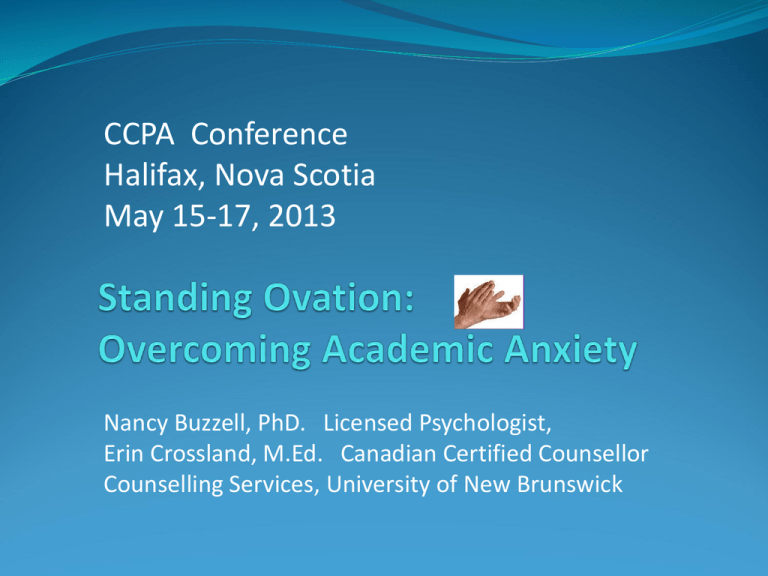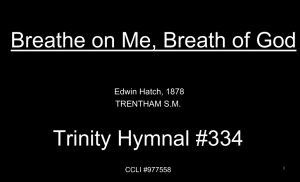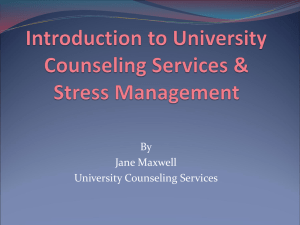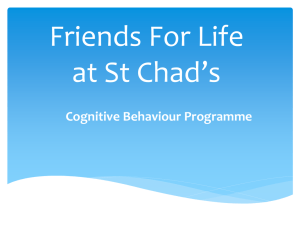Standing Ovation: Overcoming Academic
advertisement

CCPA Conference Halifax, Nova Scotia May 15-17, 2013 Nancy Buzzell, PhD. Licensed Psychologist, Erin Crossland, M.Ed. Canadian Certified Counsellor Counselling Services, University of New Brunswick What do athletes, class presenters, performing artists and thesis defenders have in common? They are required to perform even when they are nervous or worried about the outcome. If you are not doing as well as you could when performing in front of others, this one and a half hour workshop will help. It uses sport psychology principals to provide you with practical skills that will help you improve your academic, artistic and/or athletic performance. Emergency System Autonomic Nervous System (ANS) Sympathetic Fight/Flight/Freeze Emergency System Heart Rate Respiration Rate Blood Pressure Muscle Tension Parasympathetic Promotes Rest, Calm, Sleep Heart Rate Respiration Rate Blood Pressure Muscle Tension Self Regulation (Volume Control) Activation Scale Relaxation Techniques Self-regulation Activation Scale Use this scale to identify the level of anxiety related to your academic performance. 1 C alm 10 A ctivated The first step in managing your activation level is to know where you are on the scale before and during your performance. Relaxation Training Body To Mind Techniques Deep, abdominal breathing Progressive Relaxation Massage Mind To Body Techniques Meditation Self-Hypnosis Visualization Which ones do you already know how to do? What one is your favorite? Place In Nature Visualization Imagine a beautiful place in nature, one you have been to before or one you are creating for the first time. Using all your senses, allow yourself to really be there. Notice what you see, the colors, types of vegetation, land formations, wild life, etc. Now notice what you hear, the sounds that go with this place, birds, insects, water, wind, etc. Notice what you feel, the temperature (hot, warm, cool), the feel of the ground as you walk along, your body as you move one foot and then the other. Notice what you smell, the fragrances and aromas that go with this place. Find a place to sit down and rest. Notice how completely comfortable, relaxed and in control you feel in your beautiful place in nature. Bring in anything you want to feel completely relaxed, safe and in control. If anything inadvertently comes into your beautiful place in nature you don’t want there, simply move it out. Return to the room and your present age. Gently and gradually alert yourself and open your eyes. Look around the room and see where you are. Really look at objects in your environment to help yourself become more present. Remember the beautiful place in nature, is a tool that can be used when ever you want to feel more relaxed and in control. Self Regulation Breathing Visualization Music Physical movement Mental cue or word Each tool can be used to either calm or energize Use these tools to help you change your activation level to perform at your best. If you are too “up” then calm yourself; if you are too “down”, then energize yourself. Positive Self-Talk What you say to yourself (self-talk) can effect your concentration, confidence and performance. Value yourself Set realistic goals Review your progress Notice small improvements Be your own “positive” coach What You Think Matters From This (negative thoughts) A: Event or B: Beliefs about situation: Class presentation event or situation: I’ll be too nervous and forget what to say. C: Consequences in terms of thoughts, feelings, behaviour: I’m going to fail! I just want to avoid the whole thing! To This (positive thoughts) A: Class B: I want to learn to C: I may get nervous Presentation: do presentations. I’m going to need to practice but will use belly breathing to calm down. Change the way you think and decrease anxiety & improve performance Automatic Negative Thoughts (ANTs) Negative thoughts (worries, concerns, past mistakes) are distractions that can effect your performance Negative thoughts can invade your mind like ants at a picnic. One ANT is not a big problem while more than a handful can cause real problems! What are some of your common ANTs ? Name one ANT you want to get rid of today? “Cool Headed Thoughts” When you catch yourself engaging in negative self-talk : 1. Stop, take a breath 2. Refocus your attention to the task at hand 3. Change it into positive self-talk. Examples: I hate class presentations! I want to over coming my fear and it takes practice. I never do anything right! This job just requires extra effort “Smart” Goals Explained Specific: Clear (identifies what, why, who, where) Measurable: Concrete criteria for measuring progress Attainable: Realistic and achievable Relevant: Important, applicable and appropriate Time-Limited: Establishing a time line for completion Setting “Smart” Goals Smart goals increase your confidence and motivation, direct your attention to important aspects of a task and help you to feel good about yourself in the process. Tips: Set goals (short term & progressive) Write goals down Identify target dates & strategies Make time to evaluate Revise goals if appropriate Reward yourself at each step SMART GOAL PATH - Example Specific – Measurable – Attainable – Relevant – Time-Limited Task A: Improve Study Habits Task B: Go to Class Task C: Improve Time Management Task D: Improve Sleep Habits Step 1: Step 2: Step 3: Make Appointment with Study Skills Centre Find a regular & quiet place to study (i.e. Library stacks) Apply learned skills (i.e. Pomodoro Technique, Prioritization charts) Step 1: Set alarms & class schedule in phone/calendar Step 2: Step 3: Get to know professor & classmates - participate Step 1: Record all assignments & exams in calendar or scheduler Take Notes during class & review notes/readings before next class Step 2: Schedule specific study time into daily schedule (i.e. Math – Ch.4@ 2pm) Step 1: Step 2: Turn off TV, Computer, Electronics etc. 30mins prior to bedtime Go to bed & get up at similar times during week & weekends (routine) GOAL: Get better grades/ improve GPA Step 3: Limit distractions (TV, phone) during studying – schedule “fun” in at another time Step 3: Limit nap frequency & duration (20-40min) & limit caffeine (esp. in evening) Achieve Goal by: Nov 25th Mental Rehearsal Best performance Stress reducing routine Mental rehearsal Best Performance Think about one of your best performances in the past. Remember the details especially your activation level at the time. Using your activation scale, rate your best performance from 1-10 with one being calm and 10 being the most energized you could be. This number will now serve as a guide for future performances. It will be up to you to use self regulation skills to adjust your activation level to reflect the ideal or optimum level during future performances. Best Performance Do you need to be closer to 1 (low or calm), in the middle or closer to 10 (high or energized) for your best performances? Stress Reducing Routine Slow your mind and body down Refocus your attention on what you are doing Use belly breathing to calm down Relax tight muscle groups Use mental cue (word or symbol) Use these strategies to get yourself back into your area of “best performance” Mental Rehearsal Tips Mental rehearsal is like a “dress rehearsal” and uses your imagination to create or recreate an experience in your mind. Take an exam, class presentation, thesis defense or artistic recital and perform a “dress rehearsal” of it in your mind. Use all your senses (see, feel, hear, smell & touch). Tips Find a quiet setting & assume a comfortable position Start with belly breathing and relaxation Recreate a past “best” performance Create a future “best” performance Use cue word to trigger memory of “best” performance Mental Rehearsal of “Best” Performance Remember the details of one of your “best” academic performances. Remember how you got ready, where you were on your activation scale, what you said and did during the performance and how you felt when it was over. Use all your senses to be in scene (see, feel, hear, smell & touch). Now “fast forward” yourself into a future “best” academic performance. Imagine yourself getting ready, using self regulation skills to adjust your activation scale, what you will say and do during the performance and how you want to feel when it was over. Use all your senses to be in scene. Give this experience a cue word so the word itself will trigger your best future performance (see handout). Relaxation Training Progressive Muscle Relaxation (see handout for script) Calming Technique Sights 5, 4, 3, 2, 1 Sounds 5, 4, 3, 2, 1 Sensations 5, 4, 3, 2, 1 Name 5 things you see, hear and feel then 4 of each, 3 of each, 2 of each and 1 of each. Take a belly breath and feel your feet on the floor between each one. References Suinn, R. (1986). Seven Steps to Peak Performance. Toronto: Hans Huber. Weinberg, R., & Gould, D. (2011). Foundations of Sport & Exercise Physiology, 5th Ed. Champaign, Il.: Human Kinetics. Williams, J. (2006). Applied Sport Psychology. Boston, MA: McGraw-Hill. (2008, June 4). The science of stress [Video file]. Retrieved from http://youtu.be/RyP8L3qTW9Q Handouts Smart Goal Path The Pomodoro Technique Belly Breathing Example of Mental Rehearsal Progressive Muscle Relaxation Script Five Minute Meditation SMART GOAL PATH Specific – Measurable – Attainable – Relevant – Time-Limited Task A: Step 1: Step 2: Task B: Step 1: Step 2: Task C: Step 1: Step 2: Step 3: GOAL: Step 3: Step 3: Achieve Goal by: Task D: Step 1: Step 2: Step 3: (date) Belly Breathing In Breath Assume comfortable position lying on floor, knees bent, feet flat on the floor or sit in a comfortable chair Place hand on belly Relax stomach muscles by gently rocking pelvis back & forth (flatten back against floor or chair) Inhale slowly & deeply through your nose and feel your belly expand When you have inhaled as much as possible, hold breath for a few seconds, then exhale Out Breath Exhale slowly through mouth making a sigh or sound Making an exhale sound helps open your throat and airways Feel belly return to original position When you have exhaled as much as possible, hold breath for a few seconds, then repeat the inhale- exhale cycle Mental Rehearsal: Example I’m sitting in my bedroom going over my presentation notes for class tomorrow. I’m feeling anxious and afraid I’ll “freeze” and not be able to remember my notes. I take several belly breaths (relaxation skills) to calm myself. I focus my attention on feeling my feet on the carpet to ground myself (physical grounding calming technique). Then I remember a best performance from my class presentation when I was in high school. I see myself standing at the front of the class, wearing my favorite outfit, looking over my notes, taking a breath to calm down (self-regulation). I am at about “4” on my activation scale (my optimal activation level). I remind myself that I am prepared (positive self-talk). I want to concentrate on what I want to say and not my fear (challenging ANTs). I remind myself to make eye contact with a few people in the class starting with one of my best friends (increase confidence). I remember getting “on a roll” and how good I feel about what I know about the topic. I remember the class clapping when I am done and the relief I feel about trying to do my best. There was even a question I answered. My cue word is “concentrate”. I see myself in class tomorrow. I am telling myself to breathe and “concentrate” on what I want to say. I will use relaxation skills to calm myself down so I am at a 4 on my activation scale before I start. I am wearing my “presentation outfit” and look older and more professional. I am following my notes and I hear myself talking slowly and clearly. I am making eye contact with some of the students in the class and the prof. I take slow breaths once and a while and remind myself to “concentrate”. I am finishing my presentation and feeling good about myself. I hear myself saying in my mind “I am proud of myself for doing the presentation even though I was nervous”. Progressive Muscle Relaxation Progressive muscle relaxation involves tensing a particular muscle or group of muscles, holding the tension for 4-6 seconds, then relaxing the muscle or group of muscles. The sequence of tensing and relaxing is repeated 24 times depending on what is most helpful to you. You can begin with the feet and work progressively toward the head or start with the head and work down toward the feet. Find a quiet space where you will not be disturbed. You can do this exercise either lying on your back or sitting in a chair, as long as you are comfortable. You can either close your eyes or leave them open. Starting with the feet, imagine there is a towel on the floor in front of you and you want to pick it up with your toes. Curl your toes under as if to pick up the towel. Hold the tension for 4-6 seconds. Now relax and let your feet go limp. Notice the tension flow out of your feet. Repeat. Press your knees together and hold the tension. Now feel your legs relax. Repeat. Tighten your thighs and buttocks by pressing your heels downward firmly. Hold this position. Then relax. Notice the tension leaving your lower body. Repeat. Clench your fists and hold the tension for 4-6 seconds. Now relax. Feel the looseness in your hands. Repeat. Bend your elbows and tense your biceps. Hold the position. Then relax and straighten out your arms. Let the relaxation flow through your arms. Repeat. Tighten your stomach and hold the tension. Now relax your stomach. Place your hand on your stomach and breathe deeply into your stomach, pushing your hand out. Hold your breath for a moment and then relax. Now arch your back without straining, keeping the rest of your body as relaxed as possible. Notice the tension in your lower back. Use slow, calm breaths to help you relax deeper and deeper. Continue relaxing and breathe gently in and out. Notice relaxation flowing into your body. Raise your shoulders toward your ears and hold the tension. Now relax. Round your shoulders forward and hold this position. Then relax. Pull your shoulders back in the opposite direction, hold, then let go. Notice your shoulders loosen and go limp. Close your eyes now and "scrunch" your entire face making as many wrinkles as possible. Now relax your face. Repeat. Feel the relaxation throughout your forehead, scalp, eyes, and jaw. Take a moment to feel your whole body relax. Feel how limp and loose your body feels. Breathe in and fill you lungs completely. At the top of your in-breath hold for a moment, then let your breath out. Take several slow, deep breaths. Now use a body scan to notice any area of your body that needs a bit more relaxation. Tense and relax these areas. Allow yourself to remain in this relaxed state for a few minutes. When you are ready gradually bring yourself back to normal by doing the following: wiggle your toes, fingers, feet, hands, smile, move your elbows and knees, slowly stretch and then stand up. Five Minute Brain-Training Meditation Breath focus is a simple but powerful meditation technique for training your brain and increasing willpower. It reduces stress and teaches the mind how to handle both inner distractions (cravings, worries, desires) and outer temptations (sounds, sights, and smells). Here's how to get started: 1. Sit still and stay put Sit in a chair with your feet flat on the ground or sit cross-legged on a cushion. Sit up straight and rest your hands in your lap. It's important not to fidget when you meditate - that's the physical foundation of self-control. If you notice the instinct to scratch an itch, adjust your arms, or cross and uncross your legs, see if you can feel the urge but not follow it. This simple act of staying still is part of what makes meditation willpower training effective. You're learning not to automatically follow every single impulse that your brain and body produce. 2. Turn your attention to your breath. Close your eyes or, if you are worried about falling asleep, focus your gaze at a single spot (like a blank wall). Begin to notice your breathing. Silently say in your mind "inhale" as you breathe in and "exhale“ as you breathe out. When you notice your mind wandering (and it will), just bring your attention back to the breath. This practice of coming back to the breath kicks the prefrontal cortex into high gear and quiets the stress and craving centres of your brain. 3. Notice how it feels to breathe, and notice how the mind wanders. After a few minutes, drop the labels "inhale/exhale." Try focusing on just the feeling of breathing. You might notice the sensations of the breath flowing in and out of your nose and mouth. You might sense the belly or chest expanding as you breathe in and deflating as you breathe out. Your mind might wander a bit more without the labels. When you notice yourself thinking about something else, bring your attention back to the breath. If you need help refocusing, bring yourself back to the breath by saying "inhale" and "exhale" for a few seconds. This part of the practice trains self awareness along with self-control. Start with five minutes a day. When this becomes a habit, try ten to fifteen minutes a day. If that starts to feel like a burden, bring it back down to five. A short practice that you do every day is better than a long practice you keep putting off to tomorrow. It may help you to pick a specific time that you will meditate every day. If this is impossible, staying flexible will help you fit it in when you can. Remember, meditation is not about getting rid of all your thoughts. Rather, it's learning not to get so lost in them that you forget your goal. Don't worry if your focus isn't perfect when meditating. Just practice coming back to the breath, again and again. McGonigal, K. (2012). The Willpower Instinct. Amazon.ca







